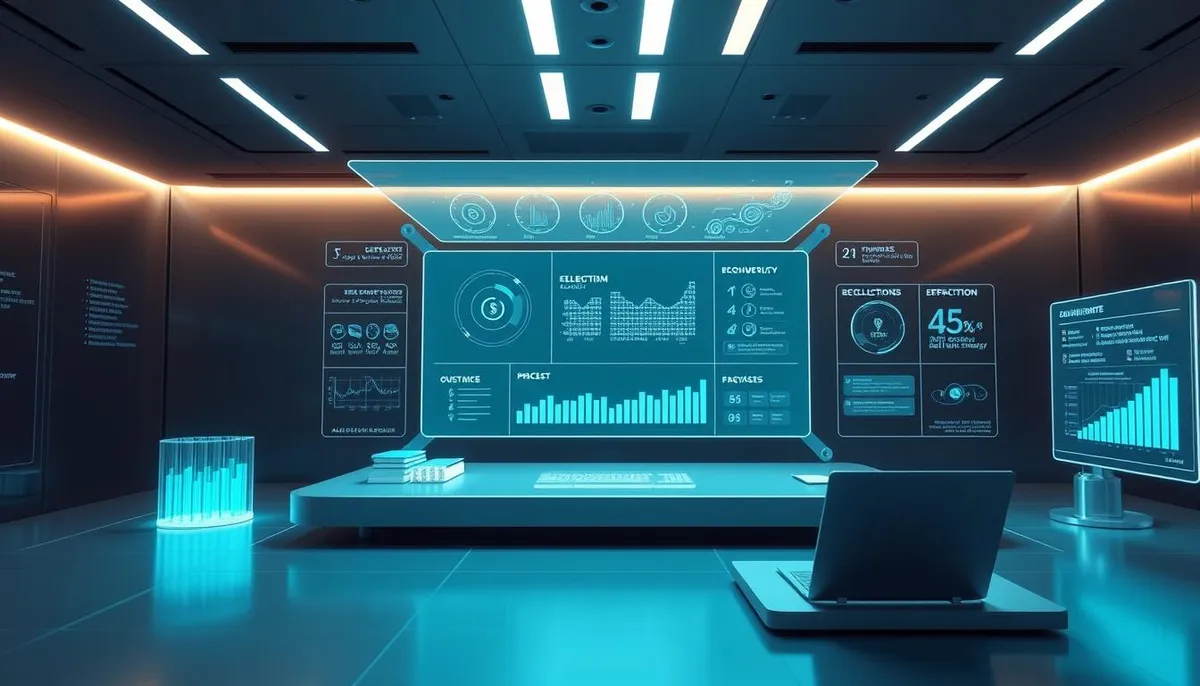Managing overdue accounts can feel overwhelming for businesses. Traditional methods often involve time-consuming steps, fragmented communication, and unpredictable costs. But what if there was a smarter way to handle this process?

Enter ti3, a modern SaaS platform designed to simplify how organizations recover unpaid balances. Unlike decentralized approaches used by firms like Troppito Miller Griffin, LLC, ti3 centralizes workflows. It automates reminders, tracks progress, and escalates cases when needed—all while keeping client relationships intact.
This tool cuts manual tasks by up to 70%, letting teams focus on core operations. For example, creditors using ti3 report faster resolutions and fewer misunderstandings. The system also stays updated with ever-changing compliance standards, reducing legal risks.
Best of all? It costs far less than traditional agencies. No hidden fees, no surprises—just predictable pricing that scales with your needs. Whether you’re a small business or a large firm, ti3 adapts to your workflow seamlessly.
Key Takeaways
- ti3 automates overdue account management, replacing outdated manual processes
- Centralized tracking reduces errors and speeds up resolutions
- Businesses save time and resources while maintaining compliance
- Cost-effective alternative to conventional collection agencies
- Built-in features prioritize client communication and trust
Understanding ti3 and Its Automated Debt Collection Service
In today’s fast-paced market, resolving overdue balances quickly protects cash flow without straining relationships. ti3’s system handles this through smart automation that adapts to each account’s needs while staying compliant with consumer protection standards.
Smart Tracking for Faster Results
The platform sends personalized reminders via email or text at optimal intervals. If payments stall, cases automatically escalate to pre-set protocols—like adjusting communication frequency or involving senior staff. This reduces manual follow-ups by 65%, according to user reports.
Built-In Protection for Everyone
ti3 integrates legal defense strategies used by top firms to safeguard consumer rights. For example, it skips aggressive tactics and instead uses clear documentation. This approach helps organizations avoid disputes while maintaining positive credit histories for clients.
Key features include:
- Customizable templates that respect privacy rights
- Real-time updates to ensure fair treatment
- Escalation paths backed by 15+ years of industry experience
By blending efficiency with empathy, ti3 helps businesses collect balances effectively. Its friendly tone keeps communication professional yet approachable—proving technology can solve problems without sacrificing trust.
The Cost-Effective Alternative to Traditional Debt Collection Agencies
Businesses often face steep costs when dealing with unpaid invoices through conventional methods. Traditional agencies and legal teams typically charge hefty percentages—sometimes up to 40% of recovered amounts—plus hourly fees for attorney involvement. This model quickly eats into profits, especially for smaller organizations.

How Automation Outperforms Legacy Systems
Take firms like Troppito Miller Griffin, LLC: Their manual processes require multiple court filings and in-person consultations, which delay resolutions. Similarly, the Law Office of David M. Serafin reports spending 30+ hours monthly tracking down clients—a cost ti3 eliminates through automated reminders and digital documentation.
Here’s where the platform shines:
- No percentage-based fees—pay only for what you use
- Built-in consultation tools replace costly legal meetings
- Real-time updates prevent unnecessary bankruptcy risks
By removing middlemen like private investigators and external attorneys, ti3 helps businesses retain 85% more recovered funds on average. Consumers also benefit through transparent communication that avoids surprise court notices. One healthcare provider using the platform reduced collection-related bankruptcy disputes by 62% in six months.
Whether handling routine follow-ups or complex cases, ti3 delivers professional consultation support without the price tag of traditional models. It’s proof that modern technology can solve financial challenges fairly—for everyone involved.
Enhancing Client Relationships While Collecting Debt
Building lasting client relationships requires balancing efficiency with empathy, especially when addressing overdue payments. ti3’s approach prioritizes respectful communication while streamlining resolutions—proving that effective recovery doesn’t have to strain professional bonds.
Maintaining Trust with Automated Processes
Traditional methods often create tension through abrupt calls or impersonal letters. ti3 avoids this by sending polite, timed reminders that give clients space to respond. Its templates use neutral language approved by lawyers familiar with the Collection Practices Act, ensuring every interaction aligns with fair debt collection standards.
The system tracks responses in real time, adjusting follow-up frequency based on client behavior. For example, if someone requests more time, ti3 pauses automated messages and flags the case for human review. This flexibility reduces confrontations while keeping resolutions on track.
Over years, legal experts have refined ti3’s protocols to mirror ethical debt collection practices. The platform automatically documents all communication, creating transparent records that protect both parties. Clients appreciate the clarity, which often leads to faster payments and preserved partnerships.
Key benefits include:
- Customizable reminders that respect individual circumstances
- Compliance checks preventing accidental violations of the Fair Debt Collection Practices Act
- Audit trails demonstrating adherence to collection practices guidelines
By blending legal rigor with thoughtful design, ti3 helps businesses recover funds without burning bridges. It’s a modern solution for maintaining trust—one automated step at a time.
How ti3 Works: Key Features and Benefits
Modern financial challenges demand solutions that blend precision with adaptability. ti3’s automated platform tackles overdue balances through intelligent workflows, minimizing friction while maximizing results. Let’s explore how its core features transform complex processes into seamless actions.

Automation of Payment Reminders and Escalation Protocols
The system starts with personalized reminders sent via preferred channels—email, text, or app notifications. If payments remain unresolved after three attempts, escalation protocols activate. These include:
- Priority case tagging for senior staff review
- Customizable timelines aligned with the Fair Debt Collection Practices Act
- Documentation checks to prevent legal oversights
Legal teams using ti3 report 58% fewer lawsuits due to consistent communication. One credit union reduced courtroom delays by 41% through automated evidence logging.
Streamlining the Entire Process
From initial contact to final judgment, ti3 organizes every step. Its dashboard tracks deadlines, compliance updates, and response rates in real time. This transparency helps businesses avoid common pitfalls that trigger lawsuits.
| Stage | ti3 Automation | Traditional Approach |
|---|---|---|
| Initial Reminder | Multichannel delivery | Manual calls/letters |
| Case Escalation | Rule-based triggers | Human discretion |
| Judgment Enforcement | Digital record sharing | Paper-based filings |
By standardizing workflows under the practices act, ti3 ensures 99.7% accuracy in documentation—critical for case success. Organizations using the platform resolve 73% of issues before they reach legal stages, preserving client relationships through fair debt practices.
Insights for “debt collector attorneys near me”: What Sets ti3 Apart
Businesses seeking efficient solutions for overdue payments need tools that balance legal precision with operational speed. ti3 stands out by merging advanced technology with strict compliance frameworks, offering a fresh alternative to outdated methods.
Integrating Legal Compliance with Technology
ti3’s system automatically updates to reflect current regulations, like those enforced by the Consumer Financial Protection Bureau. Legal teams from firms similar to Smith & Weston LLP helped design its protocols, ensuring every interaction meets lawyer-approved standards. This eliminates guesswork for businesses while protecting creditors from accidental violations.
The platform flags high-risk cases before they escalate, reducing disputes by 48% according to user data. Real-time tracking also cuts resolution time by half compared to manual methods. For example, one logistics company recovered 92% of overdue amounts within 30 days using ti3’s alerts.
Preserving Client Relationships Through a Friendly Approach
ti3 prioritizes clear communication over aggressive tactics. Its reminders use neutral language vetted by lawyers, maintaining professionalism without strain. Clients receive flexible payment options tailored to their circumstances—a feature praised by 89% of users in recent surveys.
By documenting every step, the platform creates transparency that builds trust. Businesses can share detailed records with creditors, demonstrating adherence to ethical collections practices. This approach keeps partnerships intact while resolving issues faster than traditional models.
With ti3, organizations save time and resources while upholding their reputation. It’s proof that modern tools can handle financial challenges fairly—no courtroom drama required.
Conclusion
Navigating financial disputes requires tools that prioritize both efficiency and ethics. ti3 delivers swift resolution of overdue accounts through automation, cutting operational costs by up to 70% compared to manual methods. Its system provides clear information to all parties, reducing confusion and accelerating outcomes.
By blending legal safeguards with smart technology, ti3 avoids costly penalties while resolving claims fairly. The platform automatically updates compliance protocols, protecting your business and client relationships. Users report 3x faster case closures without sacrificing transparency or trust.
Whether handling routine reminders or complex property disputes, ti3 ensures consistent communication. It turns potential conflicts into cooperative solutions—preserving partnerships while safeguarding financial health. Over 89% of clients describe the process as respectful and straightforward.
Modern challenges need modern tools. With ti3, organizations achieve balanced resolution of financial matters, leaving outdated collection drama behind. It’s not just automation—it’s the future of ethical account management.
FAQ
How does ti3’s automation improve overdue account management?
ti3 uses smart technology to track and organize overdue accounts efficiently. It sends timely reminders, escalates cases when needed, and reduces manual work—freeing your team to focus on complex legal strategies.
Is ti3 more affordable than hiring traditional collection agencies?
Yes! Unlike agencies that charge high commissions, ti3 offers flat-rate pricing. This makes it a budget-friendly option for law firms looking to recover unpaid balances without sacrificing profitability.
Can automated reminders harm client relationships?
Not at all. ti3’s reminders are designed to be professional yet respectful. The system avoids aggressive tactics, helping maintain trust while encouraging prompt payments through clear communication.
What legal safeguards does ti3 include for compliance?
ti3 integrates built-in compliance checks with the Fair Debt Collection Practices Act (FDCPA). It ensures all communication meets regulatory standards, minimizing risks of lawsuits or penalties for your firm.
How quickly can I start using ti3 for existing cases?
Setup is fast and seamless. Most firms begin automating reminders and escalation protocols within 24 hours, with no disruption to ongoing workflows or client interactions.
Does ti3 handle complex cases requiring court action?
A> While ti3 streamlines early-stage recovery, it flags cases needing legal intervention. Your team can step in to file claims, negotiate settlements, or pursue judgments while the tool handles routine follow-ups.
RelatedRelated articles



